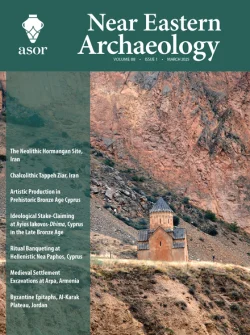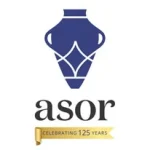
Table of Contents for Near Eastern Archaeology 88.1 (March 2025)

Pp. 4–14: “From Seasonal Hunting Base to Permanent Settlement: Insights from the High-altitude Hormangan Site,” by Morteza Khanipour and Masashi Abe
The lifestyle and subsistence patterns of Neolithic people during the second half of the seventh millennium BCE has become a topic of scientific discussion worldwide. This topic has rarely been discussed in the archaeology of Iran. Based on findings from the Hormangan archaeological site, this article discusses this period in southern Iran within the broader context of southwest Asia. The paper introduces the findings of the excavation of the Hormangan site. It also discusses why the subsistence pattern of Fars societies changed in this period, and the development of Neolithic societies toward social complexity. These changes were likely caused by climatic shifts during the second half of the seventh millennium BCE.
ASOR Members with online access: log into ASOR’s Online Portal here. Once logged in, click the JOURNALS tab in the top navigation bar. Tutorials for how to log in to the Online Portal as well as how to navigate to the Portal Journals page can be found here.

Pp. 16-23: “Tappeh Ziar: A Chalcolithic Site along the Zayandeh Rud River Basin (ZRB) in Isfahan, Iran,” by Jaleh Kamalizad and Alireza Sardari
The Zāyandeh Rūd River played an important role in shaping the society of ancient Isfahan, although the river basin had not been well investigated archaeologically. In 2021 an archaeological survey was conducted by the Isfahan Hydraulic Heritage Project along the Zāyandeh Rūd River. Roughly thirty kilometers southeast of the city of Isfahan, prehistoric pottery sherds attributed to the Bakun period came to light on the surface of a tell-site called Tappeh Ziar. The analysis and comparison of the sherds show some interactions with the Fars prehistoric cultures, especially the Kur River Basin during the fifth millennium BCE.
ASOR Members with online access: log into ASOR’s Online Portal here. Once logged in, click the JOURNALS tab in the top navigation bar. Tutorials for how to log in to the Online Portal as well as how to navigate to the Portal Journals page can be found here.

Pp. 24-34: “Art as the Child of Nature: Investigating the Interplay between Human Society, Environment, and Artistic Production in Prehistoric Bronze Age Cyprus,” by Zuzana Chovanec
This article presents research that examines how changing characteristics of the natural world were incorporated into ancient Cypriot art. A key objective is to synthesize and apply data pertaining to the distribution and socioeconomic uses of animals during the Bronze Age to analysis of their representation in Cypriot material culture. This permits trends in human-environment relationships to be examined, including characteristics of transported landscapes, changing attitudes toward the natural world, the evolution of artistic convention, and, more broadly, the interplay between human occupation, cultural production, and environmental impact in Cyprus during a period of increasing social, economic, and cultural integration. Preliminary observations pertaining to animal representations in the prehistoric Bronze Age in Cyprus are presented.
ASOR Members with online access: log into ASOR’s Online Portal here. Once logged in, click the JOURNALS tab in the top navigation bar. Tutorials for how to log in to the Online Portal as well as how to navigate to the Portal Journals page can be found here.

Pp. 36-46: “Ayios Iakovos-Dhima, Ideological Stake-Claiming, and Social Reproduction in Northeast Cyprus in the Late Bronze Age,” by Thomas John William Humphrey
This article reexamines the Late Bronze Age activity at Ayios Iakovos-Dhima in the northeast of Cyprus to better understand the nature of the activity at the site. A detailed spatial and biographical examination of the finds draws on a recent analysis of the unpublished sherds suggesting a more complex stratigraphy and dating than previously thought. This is combined with an examination of the site’s location, phases of use, and local and regional context to explore Dhima’s place in the ritual landscape of northeast Cyprus. The surviving MC III/LC IA evidence suggests Dhima was used as a means of ideological stake-claiming during a period of upheaval, while the importance of the site appears to have influenced its later use for similar purposes. The LC IB/IIA activity at the site appears to have been centered around performative rituals of commensality and libations as a means of ideological stake-claiming and social reproduction.
ASOR Members with online access: log into ASOR’s Online Portal here. Once logged in, click the JOURNALS tab in the top navigation bar. Tutorials for how to log in to the Online Portal as well as how to navigate to the Portal Journals page can be found here.

Pp. 48-56: “Ritual Banqueting at a Hellenistic Sacred Area on the top of Fabrika Hill, Nea Paphos,” by Jolanta Młynarczyk
A joint French-Polish team carried out excavations in the southern part of a hillock known as Fabrika in Nea Paphos from 2018 to 2022. The foremost focus of the research was the detailed investigation of a temple site recognizable in a rock-cut platform and with some confidence attributed to the cult of Paphian Aphrodite. Careful examination of the temple’s surroundings led to the identification of three different places in which ritual banquets were being held during the Hellenistic period. Each of the respective banqueting places, dated on the basis of associated ceramics and coins, had a different appearance and character, doubtless having been destined for diverse groups of participants.
ASOR Members with online access: log into ASOR’s Online Portal here. Once logged in, click the JOURNALS tab in the top navigation bar. Tutorials for how to log in to the Online Portal as well as how to navigate to the Portal Journals page can be found here.

Pp. 58-69: “Medieval Settlement Excavations at Arpa, Armenia: Regional Context and Chronology for a Silk Road Town,” by Astghik Babajanyan and Kate Franklin
This article focuses on the medieval Arpa settlement, situated in the Vayots Dzor region of the Republic of Armenia. The site of Arpa was a significant settlement in the Middle Ages; since the nineteenth century the site has been used as a cemetery, resulting in significant destruction to the medieval layers. This article presents the results of the 2023 season of excavations in the eastern extent of the settlement, an attempt to recover material assemblages, and addresses the early chronology of the site. In the process of these excavations, living and working contexts from the later Middle Ages (fourteenth–fifteenth centuries CE) were uncovered. The discussion of these contexts and their assemblages provides new information on the end of the Middle Ages in Armenia and a transitional period in the overland movement of people and goods referred to by later scholars as the Silk Roads.
ASOR Members with online access: log into ASOR’s Online Portal here. Once logged in, click the JOURNALS tab in the top navigation bar. Tutorials for how to log in to the Online Portal as well as how to navigate to the Portal Journals page can be found here.

Pp. 70-77: “Byzantine Epitaphs: Unearthing New Sources of Christian Socioreligious Landscape from Southeastern Al-Karak Plateau (Southern Jordan),” by Musallam R. Al-Rawahneh
The objective of this article is to bring to light seven previously unpublished Byzantine funerary inscriptions discovered in the southeastern Al-Karak Plateau (southeastern Moab, Jordan). These inscriptions are currently preserved in the Al-Karak Archaeological Museum in southern Jordan. Fortunately, most of these inscriptions are in relatively good condition, and the scripts correspond to types 2, 3, and 4 of the Canova classification. The inscriptions bear a striking resemblance to the many epitaphs from the fifth through seventh centuries CE carved on rectangular tombstones and adorned with Christian symbols in the same region.
ASOR Members with online access: log into ASOR’s Online Portal here. Once logged in, click the JOURNALS tab in the top navigation bar. Tutorials for how to log in to the Online Portal as well as how to navigate to the Portal Journals page can be found here.


